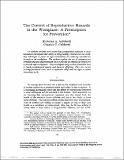| dc.contributor.author | Ashford, Nicholas A. | |
| dc.contributor.author | Caldart, Charles C. | |
| dc.date.accessioned | 2002-08-05T18:54:29Z | |
| dc.date.available | 2002-08-05T18:54:29Z | |
| dc.date.issued | 1983 | |
| dc.identifier.other | pp. 523-563 | |
| dc.identifier.uri | http://hdl.handle.net/1721.1/1549 | |
| dc.description.abstract | As workers become more aware that occupational exposure to toxic substances can impair their ability to bring healthy children into the world. they will begin to focus on legal mechanisms for reducing reproductive hazards in the workplace. The authors explore the use of compensatory remedies and anti-discrimination laws to provide an impetusfor employers to provide safe workplaces. hey investigate using workerprotection laws to reach psychological injuries and harm to offspring. They also survey existing preventive tools such as injunctive relief and the right to refuse hazardous work | en |
| dc.format.extent | 4078992 bytes | |
| dc.format.mimetype | application/pdf | |
| dc.language.iso | en_US | |
| dc.relation.ispartofseries | Industrial Relations Law Journal, Volume 5, Issue 3; | |
| dc.subject | hazardous work. | en |
| dc.subject | Law and Regulation | en |
| dc.subject | reproductive hazards | en |
| dc.title | The Control of Reproductive Hazards in the Workplace: A Prescription for Prevention | en |
